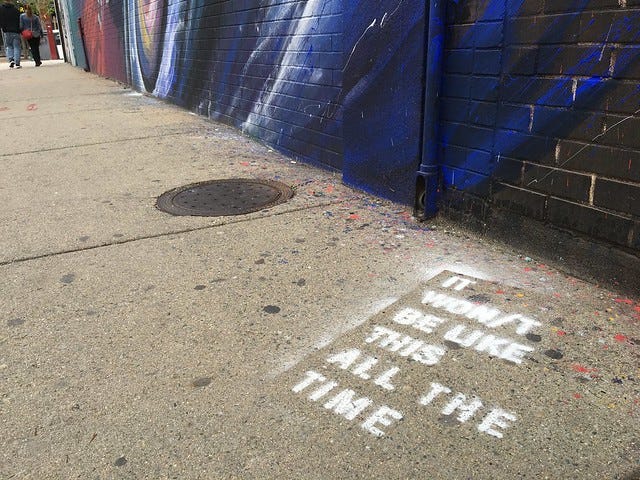“In a world of relativism and cowardice, freedom is the absolute among absolutes, the value of values.” ― Timothy Snyder, On Freedom
“The word 'fear' comes from the Old English term for danger, while 'anxious' is derived from the Greek root word meaning to 'press tight' or strangle.” -- Peter A. Levine: Waking the Tiger
In one our various encounter groups, we taught something called “Go for the roar,” or “Going for the roar.”
The story goes along these lines.
“In Africa, the elder lions are too old to hunt and chase gazelles for food. So, the older lions will lie in the bush and stay hidden from sight. The younger lions then chase a herd of gazelles toward the bush and, as the gazelle’s race toward the bush, the older lions leap up and let out a loud roar. The gazelles then freak out and turn around and run right back into the jaws of the younger lions and are killed for dinner. If the gazelles continued running through the older lions (the ‘roar’) they would race to freedom.”
We teach this as a look at fear and courage and how to deal with adversity and/or tense situations. When faced with conditions that are overwhelming and scary, in most cases the courageous thing is to go headlong into the flames, to go for the roar.
This logic can come in handy in ‘normal’ situations such as a job interview or trying something for the first time. There is a normal level of trepidation when dealing with the unknown. Sometimes we call it ‘butterflies,’ and these can be healthy responses to uncertain situations.
This Will Never Change?
Where this gets tricky is if a person suffers from CPTSD/PTSD or Generalized anxiety disorder (GAD)…or a Traumatic Brain Injury (TBI).
“Traumatized people chronically feel unsafe inside their bodies: The past is alive in the form of gnawing interior discomfort. Their bodies are constantly bombarded by visceral warning signs, and, in an attempt to control these processes, they often become expert at ignoring their gut feelings and in numbing awareness of what is played out inside. They learn to hide from their selves.” -- The Body Keeps the Score: Brain, Mind, and Body in the Healing of Trauma
A person with PTSD can react to everyday situations with an abnormal level of distress. Something as benign as a loud noise or even a phone call can ‘trigger’ an emotional response that unleashes unnatural amounts of chemicals and hormones in the brain and body.
“One of the key symptoms of PTSD is experiencing intense fear, anxiety, or distress when confronted with reminders of the traumatic event, even if the present situation is not actually dangerous or threatening.” --SimplyPsychology
In these triggered states, it is nearly impossible to “Go for the roar.” The roar is overwhelming and there are high levels of Cortisol, Epinephrine, Norepinephrine and Adrenaline released in the body. Someone suffering from severe PTSD may lose control. That person is “Dysregulated.”
“The long-term, alarming, debilitating, and often bizarre symptoms of PTSD develop when we cannot complete the process of moving in, through and out of the 'immobility' or 'freezing' state.” -- Peter A. Levine: Waking the Tiger
This has nothing to do with courage. The primal instincts of “fight or flight” are no longer operative. PTSD introduces the “Three F’s,” Fight, Flight or Freeze. In many/most cases, PTSD sufferers will freeze. The past traumas are so deeply ingrained, there simply is no fight or flight. Freezing is the only logical response because it prevents a further shock to the system from massive hormones. Immobilization is a protective response to trauma.
“These posttraumatic reactions feel incomprehensible and overwhelming. Feeling out of control, survivors of trauma often begin to fear that they are damaged to the core and beyond redemption.” -- The Body Keeps the Score: Brain, Mind, and Body in the Healing of Trauma
This feeling of being “damaged goods” only adds to the trauma. There is already this overwhelming sense of hopelessness, and it is accented by this feeling that this will never change.
In many cases, going for the roar may increase feelings of anxiety and stress…leading to panic attacks and thus the depression of ‘failure.’ The feelings of ‘permanent brokenness’ can come from judging your own overreactions of having a dysregulated response to a situation that most people would simply deal with in a regulated manner.
Out Not Through: Rumpelstiltskin?
“The organism must find a way out of the cycle created by the perception of danger and the accompanying arousal in order to regain its equilibrium.” -- Peter A. Levine: Waking the Tiger
In Bessel van der Kolk’s: The Body Keeps the Score, he goes through a number of therapies including EMDR, internal family systems, yoga, neurofeedback, psychomotor therapy, and theater.
The bottom line, it comes down to “safety.” In the state of the Three F’s it is impossible to feel ‘safe.’ Everyday encounters with other people can often feel terrifying…like being a room full of aliens.
In the Grimm’s fairy tale, when the girl was able to name Rumpelstiltskin, she eviscerates him. Depending on which version of the story, Rumpelstiltskin is torn in two or is sucked into the earth. The key is in the naming.
Though the path to healing may be long and difficult, seeing the trauma for what it is and being able to name the trauma can be one pathway ‘through.’ It could be a step towards the roar that does not further inflame stress hormones.
Levine refers to this as “trusting the arousal.” I have come to understand it as “naming the arousal.” It doesn’t change anything about the arousal itself, it merely offers recognition. It deepens the understanding. There is no magic shutoff valve where suddenly the cortisol shuts off, the shaking stops, the tears subside…but it offers a clarification to the overwhelm.
The one thing I am learning is that it is a long process. Some people will benefit from the therapies that van der Kolk uses in his trauma centers, others have found relief with drug therapy…although van der Kolk is a physician who advocates against chemical treatments.
Without any empirical evidence, I have a feeling that music is a natural method of helping to heal trauma. Until or unless we can invent time machines and go back and “…start again, a million miles away,” we are left with baby steps.
The goal is to no longer be: “Full of broken thoughts I cannot repair.”







